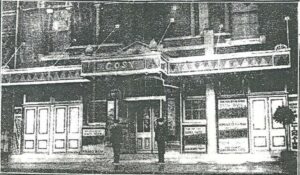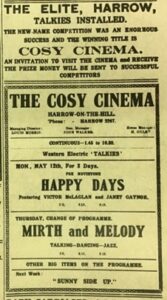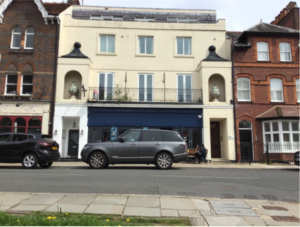Annette Kuhn presents some written memory work creations
Last September’s blog, ‘Chroniclers of Picturegoing’, surveyed a number of personal documents held in the Cinema Memory Archive—records of cinema visits and listings of films seen by Cinema Culture in 1930s Britain (CCINTB) participants. Many of these had been made at, or very close to, the time the visits took place; some had been compiled after the 1930s; while others were put together in the 1990s in direct response to calls for participants in the CCINTB project.
Each of these records is shaped by the writer’s conception of its purpose and intended readership. For example, a simple list of films seen might have been compiled initially as an aide-memoire for the writer or purely for the joy of list-making; or it might include comment, explanation or exposition addressed to the writer’s peers, family members, descendants—or to posterity. Accounts of cinema visits written at some distance in time from the events recorded may embody an element of hindsight, looking back or reflection on the writer’s part: these, by definition, are in some way or other productions of memory.[1]
CCINTB participants’ written ‘memory work creations’ take the form of essays, published and unpublished articles and long-form, essay-style, letters. None of these were actively solicited from participants. Many arrived in the CCINTB office in response to press and radio calls for 1930s cinemagoers to make themselves known to the project. Others were elaborations on responses to CCINTB’s 1995 postal questionnaire survey: along with their completed forms many respondents enclosed detailed recollections of and thoughts on their youthful cinemagoing. A number of written memory work creations were donated by CCINTB interviewees.
Produced by men and women living in various parts of Britain and representing a range of social backgrounds, life experiences and relationships with films and cinema (“ordinary” cinemagoers, film-lovers, avid fans of particular stars, people with personal connections with the film industry), these writings vary in style and content. At the same time, they share some common features of tone and address, ranging from carefully constructed and expressed ‘writerly’ accounts to enthusiastic and spontaneously expressed reminiscences–from the ‘composed’, that is, to the ‘heartfelt’.
The ‘composed’ writings incorporate a variety of themes, styles and intended or implied readerships. Some are memoirs of the writer’s cinemagoing life, taking the form of ‘motion picture autobiographies’ written perhaps for their own satisfaction or prompted by a CCINTB call for contact from 1930s cinemagoers. These typically open with an account of the writer’s first remembered trip to the pictures and then trace his or her cinemagoing activities through subsequent years. There are also a number of essays on films and cinemagoing in the 1930s that are framed to some extent as witness accounts and also presented in terms of their social-historical contexts. These ‘community histories’ are writings of a kind that might be produced in reminiscence groups, say, or writing workshops. CCINTB participants’ motion picture autobiographies and community histories frequently mix autobiography and history.[2]
‘Composed’ stories about film location shoots witnessed by the writer as a bystander make for lively reading; while ‘insider’ recollections by participants who had worked in cinemas or experienced other personal connections with the film business might convey the quality of the ‘oft-told tales’ that are typically conveyed orally: their spoken-word quality reaches out to the reader, sometimes in a ‘heartfelt’ manner. The most unambiguously—and movingly–heartfelt expressions, though, take the form of letters penned in spontaneous and enthusiastic response to CCINTB’s media calls. Seizing the opportunity to relive youthful pleasures, these participants express delight that the memories they treasure might be of interest to others.
1.‘Motion picture autobiographies’: Mick Mitchell, Raymond Aspden, John Ford and G.W. Pleasance
In his 1948 study of cinema audiences in Britain, the German-British sociologist J.P. Mayer adopted a method of empirical inquiry into film audiences that had been developed in the influential Payne Fund Studies conducted in the USA in the 1930s: the motion picture autobiography.[3] Seeking to gather data on the place of films in British cinemagoers’ lives, in 1940 Mayer asked readers of the popular weekly film magazine, ‘The Picturegoer’, to write to him about how they first became interested in films, who they went to the cinema with and their film preferences at different ages.
Mayer’s informants were overwhelmingly young, members of a generation who, like CCINTB’s participants, grew up with cinema in the 1930s. Their motion picture autobiographies are consequently composed ‘on the pulse’ rather than from the standpoint of older people looking back on their youthful picturegoing from a distance of several decades. Moreover, Mayer’s informants were given instructions on how to compose their motion picture autobiographies; CCINTB participants were not prompted at all. However, while the CCINTB memoirists appear to have adopted the motion picture autobiography approach more or less instinctively, none of them record a lifetime of cinemagoing–perhaps due to the project’s declared interest in the 1930s. More significantly in terms of the operation of memory,however, it undoubtedly also reflects the fact that most of the CCINTB participants had given up regular cinemagoing on reaching milestones of the life course such as marriage or starting a family–events that for many of them coincided with the nationwide decline in the cinemagoing habit and the widespread cinema closures that took place from the 1950s.
That said, though, the memoirs of Mayer’s informants and of CCINTB participants are alike in some respects, most notably in their opening gambits:
My first introduction to films was at the age of seven, when my parents […] decided that I was big enough to go with them [and] took me about once a fortnight to one of the local cinemas. (Male, age 21, occupation audit clerk/soldier) [4]
I was probably about seven years old when my cousin Gordon took me to the Children’s Matinee for the first time at the Coliseum. (Mick Mitchell)
The second quote is from an essay entitled ‘Some Recollections of Cinemagoing’, which was composed expressly for CCINTB in 1995, at around the time the writer was interviewed for the project. Its author, Mick Mitchell, was born in Liverpool in 1926 and his motion picture autobiography covers the period between the early 1930s and the late 1940s—from his childhood until his early twenties [PM-95-024PW001]. It includes notes on cinemas frequented and films seen in his home city and when away from home on family holidays. Mr Mitchell also mentions his cinema visits as an evacuee in North Wales at the start of World War 2 and describes his first job on leaving school (packing and delivering film reels for a distribution company). He looks back on film screenings he attended while on military service in Egypt and Greece after the war:
During my nine-month stay [in Macedonia] we had two or three visits from the Army Kinema Corps (AKC). Our camp had no suitable building for the showing of films, so the projector was set up on an earthen bank and aimed at a whitewashed wall. On one occasion we were shown a boring film and our attention was distracted by the sight and sound of gunfire, some five or six miles to the west, where the Communists and the Royalists were shelling each other. We had a certain regard for the AKC. The projectionist, usually a one-man band, would appear at a camp, having travelled alone in a pickup truck, with a projector and films.
*
In Summer 1995, Raymond Aspden (born in 1923 in Blackburn, Lancashire) saw a newspaper article about CCINTB and responded by composing a long, essay-style, letter setting out his recollections of cinemagoing during the 1930s, “from the viewpoint of a young boy to a young teenager” [RA-95-232PL001]. Launching into his account in classic motion picture autobiography style, he writes:
My first recollection of the cinema was being taken to see All Quiet on the Western Front, which stayed vividly in my memory, especially the scene at the end where the young soldier strays above the trench to catch a butterfly and is shot by a sniper.
He goes on to name local cinemas, mentioning memorable films and stars, describing boyhood ruses for getting in without paying–and alluding to the joys and hazards of continuous programming:
Starting at two o’clock and continuing till late evening. I enjoyed Lives of a Bengal Lancer so much that I sat through it twice. My mother going berserk when I got home wondering where I could be.
*
In February 1995 John Ford (born in Bristol in 1923) saw an announcement about CCINTB in a monthly newspaper for pensioners, and in response composed a four-page typed essay entitled ‘Going to the Pictures in the Nineteen Thirties’ [JF-95-141PL001]. Mr Ford’s motion picture autobiography covers his main period of cinemagoing, which he frames as coinciding exactly with the decade. His account follows his family’s several house moves during the thirties, with details of cinemas and cinema visits in each new location, along with some lively recollections of films and stars:
In 1936 the family moved to Watford, a hybrid dormitory/industrial town fifteen miles northwest of London. As far as cinemagoing was concerned I could hardly believe my luck, Watford boasted six cinemas. The Plaza (later Odeon), the Gaumont Palace, the Charlton, the Regal, the (fleapit) Coliseum (later New Plaza) and North Watford Odeon [where] I saw my first full-length colour film, Annabella (whoever she was) in Wings of the Morning, a sentimental weepie about a racehorse which gave its name to the film title.
*
In August 1995 G.W. Pleasance of Bury St Edmunds in Suffolk contacted CCINTB in response to an article about the project in a regional newspaper, and later that year took part in our postal questionnaire survey [GP-95-289GQ001]. In addition to completing the questionnaire he composed and typed a six-page essay [GP-95-289PW001].
Born in 1922, Mr Pleasance grew up in Shepherds Bush, west London; and his motion picture autobiography covers the period between around 1930 and 1950. While he vaguely remembers being taken to the cinema at the age of about four, the real beginning of his interest in filmgoing, he says, came a few years later:
The first all talking film I can remember seeing was Atlantic (1929), a German/British production of the Titanic disaster, it was showing at the New Park Cinema, Shepherds Bush.
The memoir continues with mentions of other local cinemas that he attended as a boy, along with recollections of one or two particularly memorable films.
Much of Mr Pleasance’s motion picture autobiography is coloured by the fact that soon after leaving school he found work as a film projectionist, which was “as near as I could get to my great interest in the film industry.” Recollecting this phase of his life, he adopts the engaged observational tone of a writer with both inside knowledge of the cinema exhibition scene in his area and, injecting history into biography, a keen awareness of wider trends in films and cinemagoing:
Many cinemas had theatre organs installed and included an interlude by a resident organist, another innovation was ‘cine variety’ with a stage show by popular artists of the day. The introduction of the afternoon matinee and the admission price reduced to sixpence was most popular with the housewives, as were the tea matinees when a tray of tea could be served to them in their seat during an interval.
[…]
By the late thirties the more sophisticated musicals appeared featuring many favourites of that era, Jeanette MacDonald and Nelson Eddy, Irene Dunne, Grace Moore, Bing Crosby, Deanna Durbin to name but a few. Any film starring these artists was sure to be an attraction. Other great partnerships were brought to the screen, the great Ginger Rogers and Fred Astaire musicals, a dance couple whose performances have never been equalled let alone surpassed. The child wonder of the age Shirley Temple could pack any cinema that showed her films.
- Community histories: Walter McCulloch, Ray Rochford and Lewis Howells
In May 1995, CCINTB visited the Harpurhey Local History Group in Greater Manchester , where one of the members gave an interview. The ‘Now and Then’ Group had been sharing recollections of daily life in their community for some time, and in 1993 produced Collyhurst Recollections, a collectively written booklet comprising short articles about various aspects of local life in past times.
Among the contributions is a piece by group member Walter McCulloch (born 1921) on leisure and entertainment in Collyhurst, an inner-city area of Manchester [EC-95-18AR002]. Illustrated with sketches, Mr McCulloch’s article describes local cinemas, adding little stories about some of them:
I have not forgotten one more miracle of the age of entertainment, the cinema, the pictures, the talkies, or whatever name it enjoyed in its progress. […] “The New Century Hall” […] was a long narrow type of building with a corrugated tin roof, all right in its infancy when it was all silent films, but what a catastrophe when talkies came in. If it rained heavily or hailstoned, the noise on that tin roof simply drowned everything out.
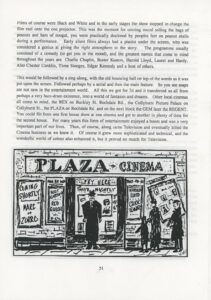 A page from Walter McCulloch’s contribution to Collyhurst Recollections [EC-95-182AR002]
A page from Walter McCulloch’s contribution to Collyhurst Recollections [EC-95-182AR002]
*
In February 1995, in response to a press announcement about the project, Ray Rochford of Salford, Greater Manchester (born 1925) sent a long letter to CCINTB which opens, without preamble: “I was born and bred in the largest concentration of slums in Europe, namely, ‘Hankey Park’, once written about by Love on the Dole author Walter Greenwood…” [RR-95-35PL001].
In it he describes the cinemas of the neighbourhood where he grew up, painting a picture of cheap entertainments enjoyed in the face of poverty and deprivation. His ‘composed’ account, written from a working-class standpoint and adopting an attitude of social observation, community history style, mixes history and biography:
Irrespective of whatever was showing at their local cinema they would dutifully trudge up the lane to watch whatever was on. They wouldn’t even contemplate going to another cinema just a few streets away. That, to them, would be utterly disloyal. Besides that, if the film was lousy they could have a good gossip and natter. When they built the Broadway in 1933 it was the first modern cinema to be erected in Salford. It certainly was an imposing edifice of mock marble with Corinthian columns either side of the imposing entrance. I vividly remember when Noel Coward’s Cavalcade was featured they had two ex-servicemen dressed in full guardsman’s uniforms including busby and wooden sentry boxes, marching up and down stamping their feet, presenting arms, the full Monty: all for five bob a night in the pouring rain, poor sods.
[….]
When I first attended the cinema around about 1929, some films were half-silent, half-talkies. I can only assume that talkies must have come out half way through making a silent film? Most of the elderly people in [Salford] couldn’t read or write, so when they went to the cinema they would take along a young grandson or granddaughter so that the child could read out the captions that came up during the film. […] I once was asked by old Tom McKenna if I’d go to the cinema with him to see one of these “half and halfs” as we then called them. […] Halfway through [the] film my throat was getting very sore because I was practically shouting at the top of my voice. I was greatly relieved to be slung out onto the cobble stones for spoiling the entertainment of all the other patrons.
*
In February 1995, responding to a CCINTB announcement in a monthly newspaper for pensioners, Lewis Howells (born in Blaenavon, South Wales in 1922) wrote to CCINTB, declaring a particular interest in the work of the project: “Several years ago I helped a local amateur publishing group with gathering nostalgic material about the way people used to live” [LH-95-100PL001]. Along with his letter was enclosed a neatly handwritten ten-page essay entitled ‘Cinema in the Town of Blaenavon, Gwent in 1930s’ [LH-95-100PW001], which opens with a community history style description of the local cinemagoing scene, complete with details of each cinema–the building, its management, its programming:
My hometown of Blaenavon had a population of approx. 10,000 in the 1930s and cinema entertainment existed at two cinemas. One of these had quite a spacious auditorium as it served as a theatre and concert venue. This was part of the building known as the Workmen’s Institute (or Hall), and really could accommodate large audiences.
[…]
The other cinema in the town, ‘The Coliseum’, was privately owned, and seemed to have access to quite a different exhibition circuit network, often netting the pictures (films) with greater box-office appeal than those showing at the other cinema. This was quite an anomaly since, being really only a small cinema, it hadn’t the capacity to take full advantage of films’ popularity.
Mr Howells then turns to more personal reminiscences, recalling occasions when he and his friends indulged in disruptive pranks at the pictures, risking “creating [a] disturbance and being ejected, banned even”. He writes about a memorable occasion when he went to the cinema with his coal miner father, who was recovering from a work accident at the time, to see a Nelson Eddy and Jeanette MacDonald film:
After his discharge from hospital he spent considerable time on crutches, and ardently following the renowned singing duo on screen he pressed me, the only other male in the house, to go with him to the Coliseum as his ‘minder’, to help him up and down the staircases and to try to guide other cinemagoers away from his broken leg and the crutches.
3.On Location: Barbara Goulter and David Moore
Though relatively few in number, ‘composed’ stories about film location shoots witnessed by CCINTB informants make for amusing reading, the events documented coming across as noteworthy because they were beyond the writer’s everyday experience—as well as being recalled as slightly ridiculous.
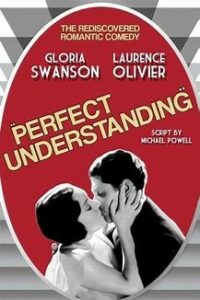 In February 1995, Barbara Goulter (born in Southsea in 1917) wrote to CCINTB in response to an article in a monthly newspaper for pensioners, enclosing a piece she had written some years earlier that had been submitted to, but rejected by, her local newspaper [BG-95-078PW001]. It consists of an archly written account of a week-long film shoot that took place in the early 1930s on the beach at the seaside town of Lee-on-Solent: “Most of Lee had opted out of its usual occupations to sit on the sea wall and watch the goings-on.” The film, featuring Laurence Olivier and Gloria Swanson, is Perfect Understanding (dir Cyril Gardner, 1933):
In February 1995, Barbara Goulter (born in Southsea in 1917) wrote to CCINTB in response to an article in a monthly newspaper for pensioners, enclosing a piece she had written some years earlier that had been submitted to, but rejected by, her local newspaper [BG-95-078PW001]. It consists of an archly written account of a week-long film shoot that took place in the early 1930s on the beach at the seaside town of Lee-on-Solent: “Most of Lee had opted out of its usual occupations to sit on the sea wall and watch the goings-on.” The film, featuring Laurence Olivier and Gloria Swanson, is Perfect Understanding (dir Cyril Gardner, 1933):
Olivier must have found it cold enough, and boring, when he spent a whole morning on one scene that involved merely swimming out to a moored boat, climbing in and starting the outboard. Of course, with this accident-prone unit nothing was that simple and it was cut and retake over and over again.
*
Former Naval officer David Moore’s (born in Hampshire in 1917) annotated list of some of the films he saw in the 1930s [DM-92-034MI001] is discussed in the September 2022 blog. The Cinema Memory Archive also holds an essay that he wrote during his retirement, recollecting his involvement in the production of a fiction film that featured the Royal Navy’s submarine service (Morning Departure, dir Roy Ward Baker, 1950): “I was given the job of liaising with the film company […] to advise them on naval customs and to provide any assistance with [my] ship’s company, plus a submarine crew” [DM-92-034PW002]. The essay offers a lively account, from an outsider’s perspective, into the filmmaking process, the filmmakers and the stars:
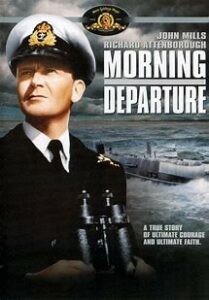 The […] departure of the submarine from alongside the ship was quite amusing. John Mills and Nigel Patrick stood up in the conning tower and gave the orders for casting off and leaving. But the real Captain and First Lieutenant were crouching down out of sight behind the bulwarks. When John Mills gave the order “Half Ahead” and the boat actually began to move, I fancied I saw a flicker of amazement cross his features as if to say, “My God, she really is moving!” Then when the submarine had run clear of the depot ship’s bows, up jumped the real captain and No. 1 and took charge, brought the boat back alongside. Certainly we had to do this shot several times before Roy Baker was satisfied.
The […] departure of the submarine from alongside the ship was quite amusing. John Mills and Nigel Patrick stood up in the conning tower and gave the orders for casting off and leaving. But the real Captain and First Lieutenant were crouching down out of sight behind the bulwarks. When John Mills gave the order “Half Ahead” and the boat actually began to move, I fancied I saw a flicker of amazement cross his features as if to say, “My God, she really is moving!” Then when the submarine had run clear of the depot ship’s bows, up jumped the real captain and No. 1 and took charge, brought the boat back alongside. Certainly we had to do this shot several times before Roy Baker was satisfied.
- Insider stories: Helen Gilmour and Zonia Ives
Helen Gilmour (born in 1922 in Ayr in the west of Scotland) contacted CCINTB in 1992 in response to an item about the project that she had heard on her local radio station. This began a correspondence that continued over eight years, in the course of which Ms Gilmour sent two essays on aspects of her lifetime involvement with cinema, both as a keen cinemagoer and as the daughter of the manager of a number of cinemas in and around the town of Ayr. A covering letter suggests that the essays were produced in a writers’ group and that they might have been intended for publication.
‘Nostalgia’, dated March 1987 [HG-92-025PW001], celebrates two unnamed cinemas in her neighbourhood: “How nice it is to recall these happy days when the Cinema was a place of escape from the realities of the workaday world.” ‘”Q” Here’, written in March 1992 [HG-92-025PW002], is a community history style account which names a number of local cinemas, adding little stories about each of them. The author notes that by 1938 Ayr boasted as many as six cinemas. Her father was Managing Director of one of them, the Ritz.
My Father negotiated the ‘booking’ of his feature films and supporting programmes and it was not uncommon to screen three programme changes each week. There were special weeks featuring Jeanette MacDonald-Nelson Eddy films which always attracted packed houses.
*
In the Summer of 1995, Zonia Ives (born in 1926 in Great Yarmouth, Norfolk) contacted CCINTB in response to an article about the project in the ‘Great Yarmouth Mercury’, her local newspaper. In a long letter [ZI-95-272PL002], she notes that her father owned and managed the Plaza Cinema in Yarmouth, “known as the local flea pit”, one of the benefits of having a showman father being that throughout her childhood she never had to pay to enter any cinema. Later in 1995, Mrs Ives took part in CCINTB’s postal questionnaire survey, and with her completed form enclosed a letter containing further details about her family and their showbiz connections, alongside memories of her father’s generosity and showmanship:
My dad and mum were music hall artistes, when variety began to die out a few artistes took cinemas all over the place. My brother started his musical career in Glasgow […] with Teddy Joyce and his 25 Kiltie Juniors.
[…]
My dad let the unemployed in the matinee for 3d. […] He would say it’s better to have a full house at 3d than an empty one at 9d [ZI-95-272PL001].
The story of the threepenny matinee for the unemployed figures in both Mrs Ives’s letters, as does another evidently oft-told tale of inexpensive treats and charity: the children’s Saturday matinee, when
The kiddies brought a 1d and a potato, they put potato’s in a sack by the cashier and these went to the local hospital which as there was no National Health Service was greatly appreciated [ZI-95-272PL001].
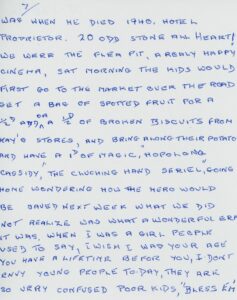 Zonia Ives relives happy memories [ZI-95-272PL002]
Zonia Ives relives happy memories [ZI-95-272PL002]
- Heartfelt memories: Zonia Ives and Doris English
In both her letters Zonia Ives expresses earnest gratitude for being given the opportunity to recall happy times:
You don’t know the good you did for me when I opened my ‘Mercury’, so I must start by saying a very big thank you! [ZI-95-272PL002]
Thank you so very much for making me think and realize what a wonderful life I’ve had. [ZI-95-272PL001]
*
In May 1995 Doris English of Cambridgeshire (born in 1916 in Birmingham) saw a press announcement about CCINTB and responded swiftly and enthusiastically:
I have always been keen to write about my teenage years of cinema. […] Now I am having my young days brought back to me by old films on TV. You can imagine the pleasure it brings me. I am 79 live alone but the years roll by and I am in my teens again. [DE-95-319PL002]
Later in the year Mrs English took part in CCINTB’s postal questionnaire survey, enclosing another letter with her completed form:
I was very pleased to help in answering all your questions you brought back many happy memories. […] PS It is nice to think that at my age 79 I am in some use to people like you. [DE-95-319PL001]
Hearing this is rewarding for researchers, too.
Other relevant CMA assets include:
MY-92-001PW001 Margaret Young Glasgow
MM- 92-008AR001 Mary McCusker Glasgow
TM-95-009PW002 Thomas McGoran Glasgow
LP-95-028PL001 Len Price Walsall
MP95-029PL001 Mary Pook Epsom
LS-95-033PW001 Les Sutton Ardwick
MS-95-065PL001 Mark Sandoz Birmingham
95-067PW001 E. Kendrick Cardiff
AC-95-071PL001 Arthur Chaney Great Yarmouth
WW-95-083PL001 William Ward Manchester
MD-95-097PL001 M. de la Bertauche Cheam
MH-95-111PL001 Margaret Houlgate Croydon
JF-95-153PL001 John Fowler Glasgow
DR-95-169PW001 Douglas Rendell Sale
EW-95-276PL001 Eric Williams Great Yarmouth
Digitised versions of some of the items referred to in this blog can be accessed via the CMDA website. All Cinema Memory Archive (CMA) items referred to may be consulted in both physical and digital form in the CMA at Lancaster University, by appointment with Special Collections.
If you wish to cite and/or re-use any of these materials, please consult the CMDA website for information on copyright and using the materials from the collection and for a citation referencing guide
[1] The issue of memory in relation to CCINTB is discussed in Annette Kuhn, Exploring Cinema Memory. Edinburgh: Argyll Publishing, 2023: Chapter 1.
[2] Relatedly, Alessandro Portelli makes a distinction between testimony and narrative in ‘Living voices: the oral history interview as dialogue and experience’, Oral History Review 45(2) 2018: 239-248.
[3] J.P. Mayer, British Cinemas and their Audiences: Sociological Studies. London: Dennis Dobson Ltd, 1948; Herbert Blumer, Movies and Conduct. New York: MacMillan, 1933.
[4] Mayer, British Cinemas and their Audiences: 53.
